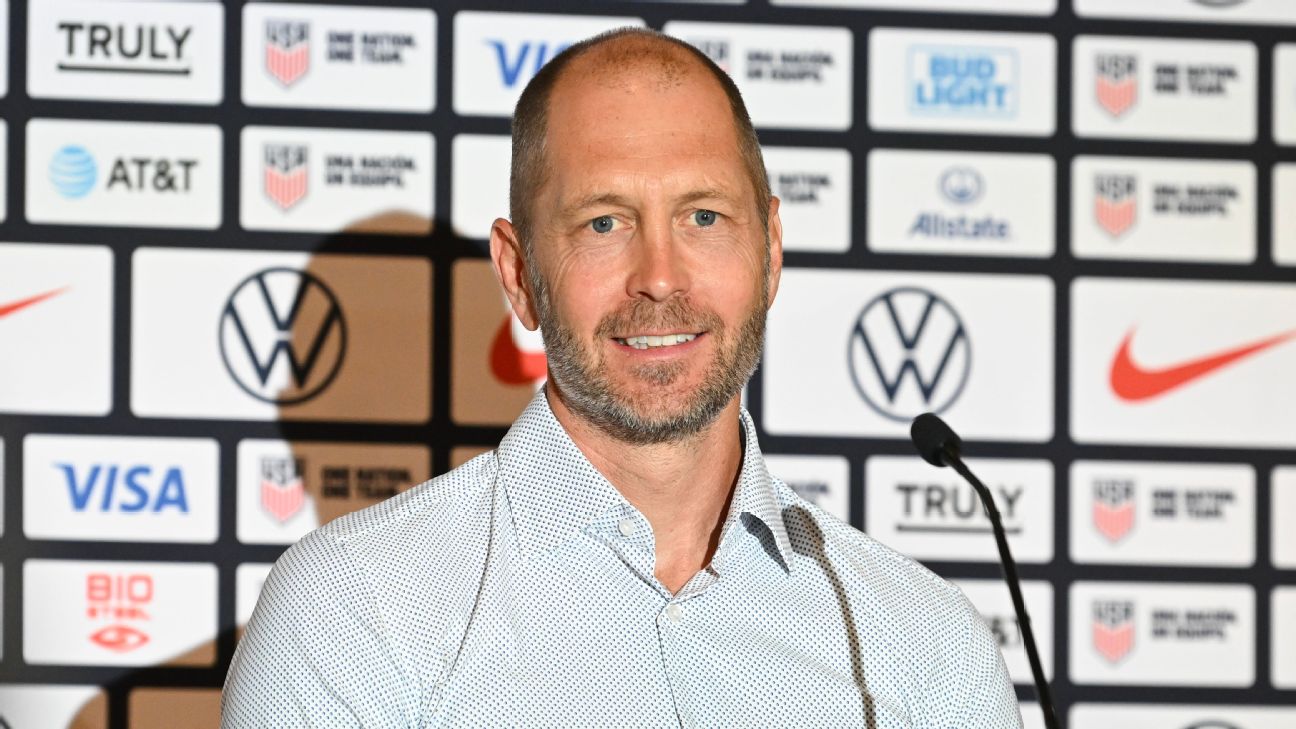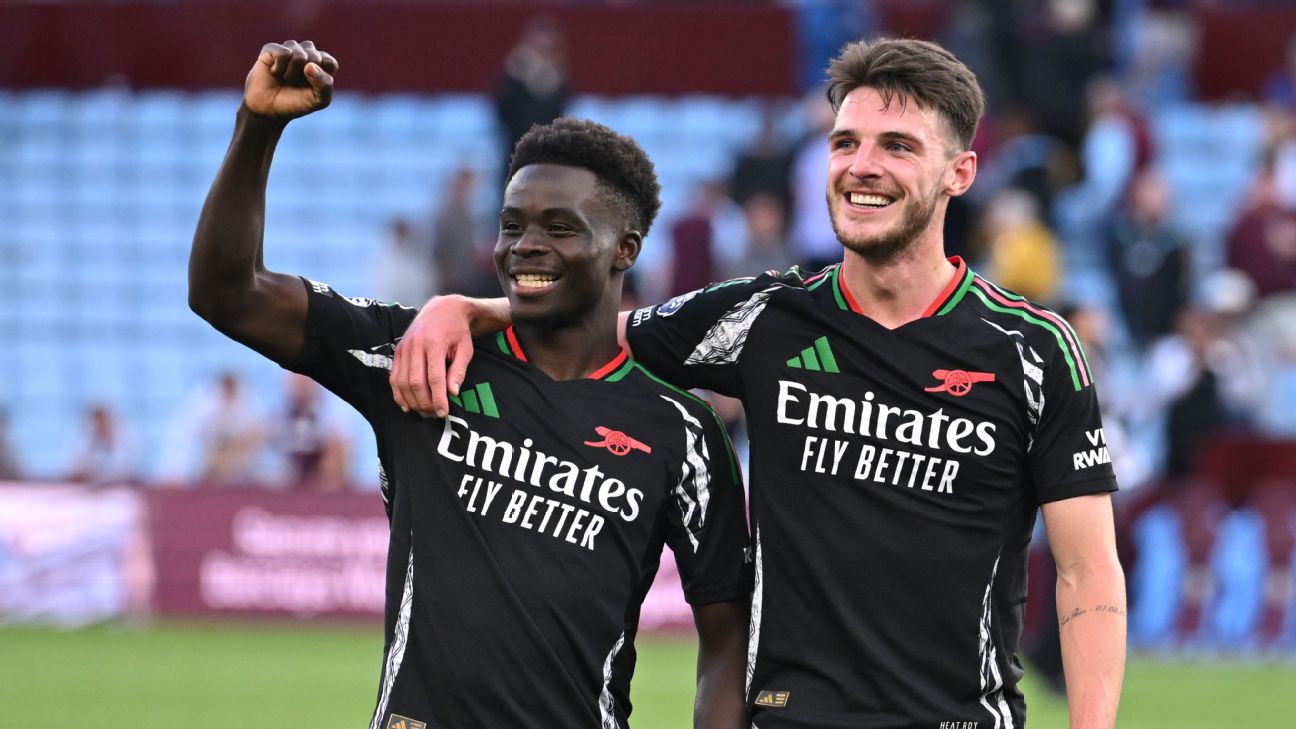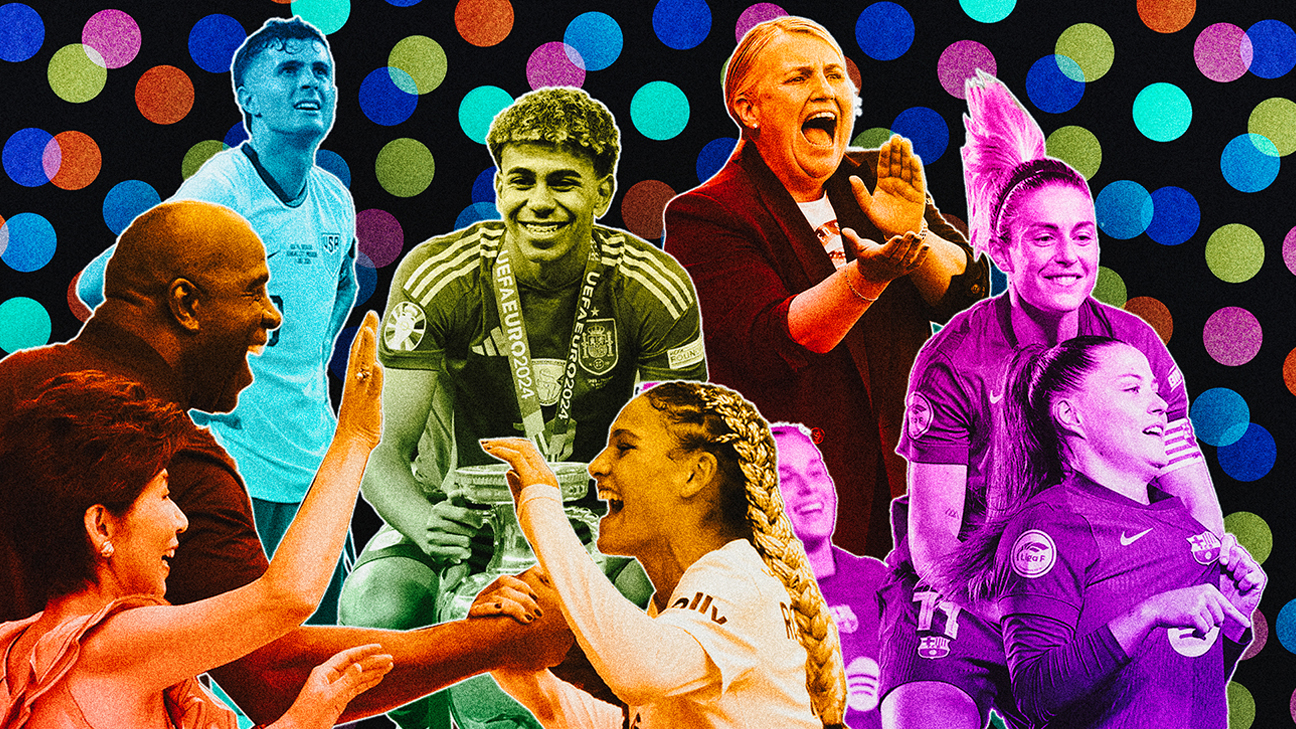At the 2022 World Cup, there was a team that didn’t allow a single goal from open play in the group stages. They drew with — and outshot — England. And they didn’t lose a game in the opening round: one win and two draws.
Sure, they lost in the round of 16, but it came against the Netherlands — a traditional world power — and this team had almost 60% of the possession in that match, also outshooting the Dutch 17 to 11. A couple of bounces go differently, and this team is playing Lionel Messi and Argentina in the quarterfinals.
Now, this team didn’t even qualify for the previous World Cup. And at the World Cup before that, this team went out in a match against Belgium that was so lopsided that the literal president of this team’s country called this team’s goalkeeper to congratulate him on all of the saves he’d made.
At every previous World Cup this team had qualified for, they’d rolled out the traditional international-underdog playbook: defend well, wait for set pieces and counterattacks. Supporters, who had been both pining for more modern tactics and to see their team perform at the World Cup, got it all in Qatar: this team played in a new way, and this team got results.
So, when this team announced that it was rehiring the same manager that guided this team at the World Cup, everyone rejoiced … right? You simple, silly person. This is the United States men’s national team: we don’t rejoice here, buddy!
Last Thursday, as the USMNT annihilated its biggest rival 3-0 and U.S. Soccer announced that Gregg Berhalter would be returning as coach, a large portion of the fan base, well, I can’t put it any better than this:
The USMNT’s polarizing manager has been locked up through the 2026 World Cup and without any real competitive matches to trip him up in the meantime, it’s incredibly unlikely that Berhalter gets fired before then. So, congrats and/or sorry, USMNT fans, you’re stuck with the dude for the next three years.
Here’s how we got here, and what that might look like over the next three-and-a-half years.
What was Berhalter’s USMNT?
It’s not an easy question to answer. The only games that really matter are the three or more games you play at the World Cup, but the three or more games at the World Cup also don’t provide anywhere near enough information about what any team participating in the World Cup actually is.
This is what makes international soccer great; this is also what makes international soccer toxic. A 38-game Premier League season that’s played every year still has plenty of room for randomness to make or break seasons and warp perceptions. The World Cup has a maximum of seven games — and it’s played once every four years.
So, perhaps keep this in mind as you invest any kind of emotional well-being into the performance of a national team: international soccer isn’t designed to identify the best teams. It’s designed to create the maximal level of drama and unpredictability. There’s barely any practice time and the teams are (for the most part) created not by savvy player identification or recruitment, but by various border-to-border citizenship laws. It’s mostly random chaos, weighted in a couple directions for various economic and historical factors.
Despite that, Berhalter’s USMNT did develop a clear identity, and whatever you think about their performance, they had an unmistakable style at the World Cup. As The Athletic’s John Muller has written about, the USMNT were one of the few national teams that looked something like a club team.
It’s really difficult to create any kind of coherent pressing system in international soccer because a functioning high press requires everyone to be on the same page. One leak in the system, and the other team is suddenly sprinting into your penalty area. However, across their four games in Qatar, the USMNT managed to push the ball into the attacking third and then keep it there.
Even against England, the one match in which the U.S. conceded possession, they mostly kept England pinned into their own defensive third and just let their defenders pass the ball sideways among themselves.
Here’s how the USMNT looked in Qatar by a pair of metrics: field tilt and possessions won in the attacking third. The former is the same thing as “possession,” but counting passes in only the final third, while the latter is obvious:
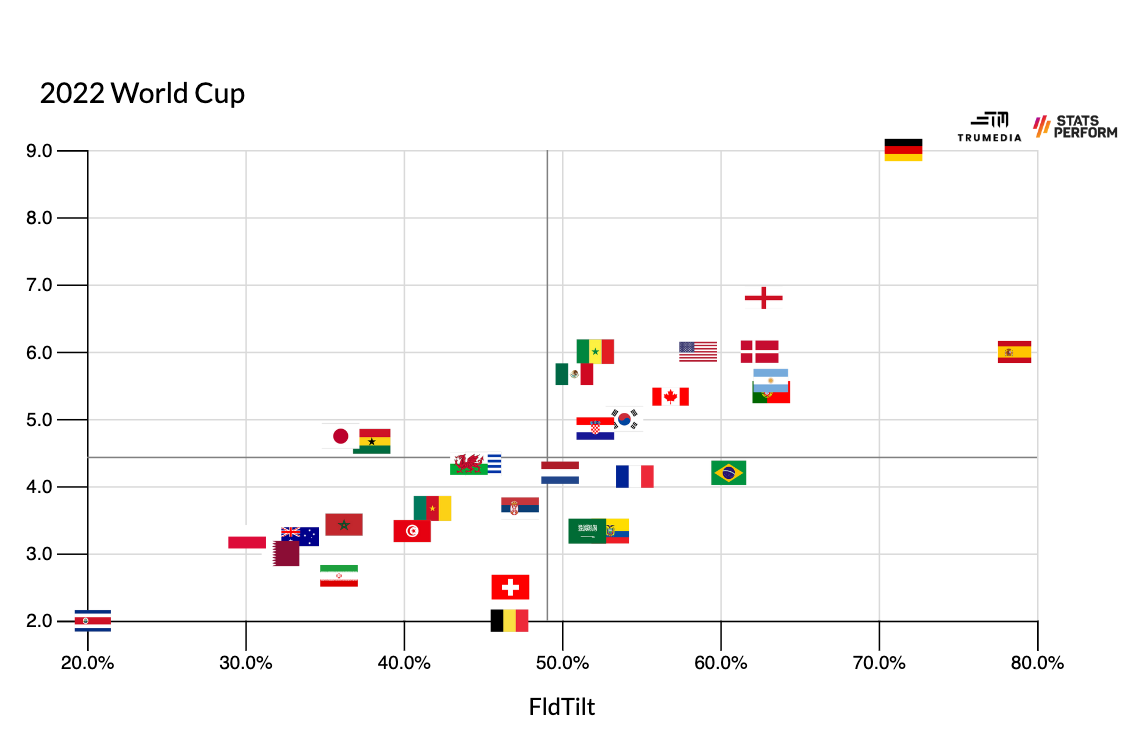
Even if they didn’t make it any further than they did in 2014 or 2010, this is new tactical territory for this team. Here’s how that same chart looked in 2014:

And in 2010:
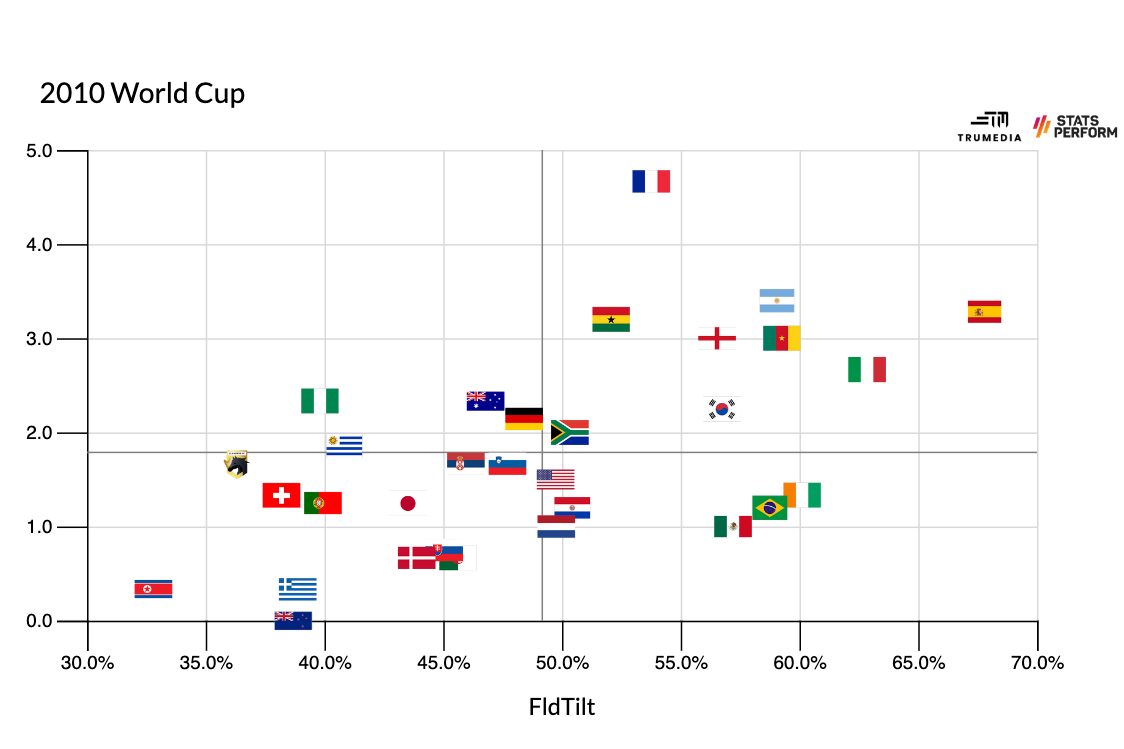
Beyond the approach, the other standout aspect of the USMNT in Qatar was the player pool. Among the 20 American players who saw the field at the World Cup, the average age, when weighted by the number of minutes played, was 24.5 years. They were the youngest team at the tournament.
What could Berhalter’s USMNT be from here?
Unless something goes horribly wrong, the USMNT will not be the youngest team at the 2026 World Cup. Were they all to return, these would be the ages of the nine players who started all four matches in Qatar when the next tournament kicks off:
-
midfielder Tyler Adams: 27
-
central defender Tim Ream: 38
-
goalkeeper Matt Turner: 31
-
full-back Antonee Robinson: 28
-
winger Yunus Musah: 23
-
winger Timothy Weah: 26
-
forward Christian Pulisic: 27
-
full-back Sergino Dest: 24
-
midfielder Weston McKennie: 27
If we consider this the “core” of the squad, then that’s seven of them in their primes, one well past it (Ream) and one still short of it (Musah). Individual player development trajectories are wonky and hard to predict, but in the aggregate, players improve as they enter their mid-to-late-20s, and most of the USMNT’s best players from the last World Cup will be in their mid-to-late-20s at the next World Cup.
For reasons completely unrelated to who the manager is, the USMNT should be better in 2026 than they were in 2022. Injuries or sudden declines in performance can throw that trajectory off, but that’s mostly unpredictable. Even with a natural amount of volatility over the next four years, the overall talent of the 2022 core should be significantly improved in 2026.
Of course, it goes beyond those nine guys, too. With Ream currently injured — and unlikely to contribute in 2026, given his age — the starting center-backs for their Concacaf Nations League victory were Chris Richards, who will be 26 in 2026, and Miles Robinson, who will be 29. Joe Scally now has two full seasons of starting playing time for a midtable Bundesliga side under his belt before his 20th birthday. He started for the suspended Dest at right-back in the Nations League final against Canada, and he’ll be 23 in 2026.
Fullback depth was a massive issue in Qatar — the talent gap between Dest and his backups was one of the biggest at any position for any team in the tournament — and Scally is certainly on the path to being a starting-caliber international player by the time the next World Cup rolls around.
Herculez Gomez speaks after USMNT vs. Mexico was ended early by the referee due to anti-gay chants.
I think most of the USMNT’s “problems” in Qatar were due to a lack of talent. I think this of most soccer teams at every level, too. “Having good players” is way more important than “having a good game plan,” and “having better players” is the solution to most of your issues.
But if there was a tactical “issue” for the U.S. in Qatar and even before the tournament, it was that they were too predictable, that everyone knew they wanted to press and keep the ball in the attacking third. The result: all that dangerous possession and all those turnovers but only three goals in four matches. They struggled to break down opposing defenses and frequently resorted to crosses into the box. (This happened occasionally in qualifying, too.)
However, you can’t just use tactics to magically create a world-class striker or a creative midfielder. You can put your players in the positions that make them most likely to succeed, but there’s only so much you can do to create goals when your starting strikers are Jesus Ferreira, Josh Sargent and Haji Wright. The U.S. had a roster filled with Champions League-level players … except at maybe the most important position on the field.
Until now, that is.
Folarin Balogun is a star. As I wrote about a few weeks ago:
“Across the Big Five leagues, only seven players have generated more combined xG and xA than Balogun: Kylian Mbappe, [Erling] Haaland, Lionel Messi, Robert Lewandowski, Mohamed Salah, Bruno Fernandes and Antoine Griezmann.”
Those are all well-established stars, while Balogun will be only 24 … at the start of the next World Cup. He’s just so much better than the other options at center forward, and he should continue to get better, too.
And then there’s Gio Reyna, who will be the same age as Balogun in 2026. In addition to a center-forward with savvy off-ball movement, the other key to consistently breaking down opposition defenses in international soccer is a creative passer. And, well, just ask Canada what happens when you put those two things together:
FOLARIN BALOGUN SCORES HIS FIRST GOAL FOR THE @USMNT IN HIS SECOND APPEARANCE! 🇺🇸 🦅 pic.twitter.com/YtrrkRNx8x
— CBS Sports Golazo ⚽️ (@CBSSportsGolazo) June 19, 2023
Of course, Berhalter benched Reyna for the majority of the World Cup, Reyna’s parents threatened to blackmail the coach, and Berhalter then gave a number of public talks in which he not-so-subtly suggested that Gio was a malcontent. It ignited the closest thing this team has ever had to a national scandal, and it put Berhalter’s wife, Rosalind, in an unfair and terrible situation she deserved to have control over.
Given everything that happened over the past few months, it seemed like it might just be best to clean house, get rid of everyone and move on. The hiring of Southampton’s Matt Crocker, an outsider with no previous connections to the USSF, to be the federation’s sporting director and to oversee the manager-hiring process suggested as much. Except, then Crocker landed on hiring Berhalter anyway after implementing a frankly absurd six-month process that made it sound like he was either leading NASA’s search to find the first astronauts to go to the moon, or trying to convince investors to buy into cryptocurrency.
In his reintroductory press conference, Berhalter said of his relationship with Reyna: “There’s work to do. … I have the obligation and commitment to coach him like I coach everyone. … He’s a game-changer.” As we saw in both Nations League matches, that last point is certainly true. The USMNT just doesn’t have the kind of depth of a team like France or Germany, where certain star players can be frozen out because they don’t fit the style or won’t work in the locker room. This team needs Reyna on the field if they’re going to reach their potential in 2026, but Reyna also needs to buy into whatever the team-wide vision is in the same way it seems like most of his teammates already have. If Reyna can do that, the USMNT should have a two-part in-house solution to their biggest problem in Qatar. If Balogun and Reyna integrate smoothly into Berhalter’s version of the team, then you’ve got a side that presses like a club team, keeps the ball in the final third and has players who can break down the deeper defenses that naturally occur in response to this style of play. The team without Reyna and Balogun was good enough to make it to the quarters in 2022. That version of the team should automatically be better in 2026 purely down to age-related internal improvement. Over the two dominant Nations League matches, it was evident that Reyna and Balogun both make the team better immediately — and they’re both likely to improve, along with all of their teammates, too. The reality of the situation is that the U.S. wasn’t going to hire some star coach to lead the national team. Plus, the two teams that had star coaches at the 2022 World Cup, Germany and Spain, were two of the tournament’s biggest disappointments. International soccer is just different, and given the talent at his disposal, I don’t really see how you can call Berhalter’s first run at it anything other than a success. However, the bar is higher now. The USMNT will be playing at home in 2026, and the team will be composed of a ton of prime-age players with tons of experience across Europe’s top leagues. Barring a bunch of unforeseen and unpredictable outcomes, the USMNT should head into the 2026 tournament with the best team in the history of the program and their best shot at making it past the quarterfinals for the first time since the tournament expanded beyond 16 teams. With Berhalter back on the sidelines, that’s all true. But with someone else in his spot, it probably would be, too.
